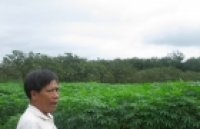| Specific members of the TOPLESS family are susceptibility genes for Fusarium wilt in tomato and Arabidopsis |
|
Vascular wilt diseases caused by Fusarium oxysporum are a major threat to many agriculturally important crops. Genetic resistance is rare and inevitably overcome by the emergence of new races. To identify potentially durable and non-race-specific genetic resistance against Fusarium wilt diseases, we set out to identify effector targets in tomato that mediate susceptibility to the fungus. For this purpose, we used the SIX8 effector protein, an important and conserved virulence factor present in many pathogenic F. oxysporum isolates. Using protein pull-downs and yeast two-hybrid assays, SIX8 was found to interact specifically with two members of the tomato TOPLESS family: TPL1 and TPL2. |
|
Thomas R Aalders, Mara de Sain, Fleur Gawehns, Nina Oudejans, Yoran D Jak, Henk L Dekker, Martijn Rep, Harrold A van den Burg, Frank L W Takken Plant Biotechnol Journal; 2024 Jan; 22(1):248-261. doi: 10.1111/pbi.14183. AbstractVascular wilt diseases caused by Fusarium oxysporum are a major threat to many agriculturally important crops. Genetic resistance is rare and inevitably overcome by the emergence of new races. To identify potentially durable and non-race-specific genetic resistance against Fusarium wilt diseases, we set out to identify effector targets in tomato that mediate susceptibility to the fungus. For this purpose, we used the SIX8 effector protein, an important and conserved virulence factor present in many pathogenic F. oxysporum isolates. Using protein pull-downs and yeast two-hybrid assays, SIX8 was found to interact specifically with two members of the tomato TOPLESS family: TPL1 and TPL2. Loss-of-function mutations in TPL1 strongly reduced disease susceptibility to Fusarium wilt and a tpl1;tpl2 double mutant exerted an even higher level of resistance. Similarly, Arabidopsis tpl;tpr1 mutants became significantly less diseased upon F. oxysporum inoculation as compared to wildtype plants. We conclude that TPLs encode susceptibility genes whose mutation can confer resistance to F. oxysporum.
See https://www.ncbi.nlm.nih.gov/pmc/articles/PMC10754003/
Figure 2. Mutant alleles of tomato TPL1 and TPL2 generated by CRISPR‐Cas9‐mediated gene editing. Two gene‐edited alleles of TPL1 were generated by targeting the 6th exon with a gRNA. The TPL protein domains are indicated in the depicted protein model (not to scale): LisH (Lissencephaly type‐1‐like homology motif), CTLH (C‐terminal LisH domain) and two WD40 repeat regions. Four gene‐edited alleles of TPL2 were generated by targeting the 5th exon. The functional gRNA sequences are highlighted in bold. The PAM sequence is underlined, the predicted cleavage site is indicated with a black arrow. Gene edits are indicated by a dash for each deleted nucleotide or a red letter for an inserted nucleotide. |
|
|
|
[ Tin tức liên quan ]___________________________________________________
|


 Curently online :
Curently online :
 Total visitors :
Total visitors :
(217).png)


